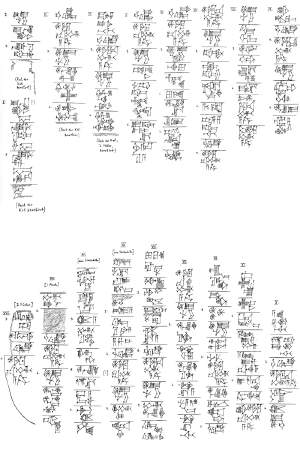(5 of 30 Incantations translated as of January 18th 2009)
Key:
a) General Introduction
b) Introduction to the Texts
c) The Texts (English Translations)
d) Notes to the Texts
a) General Introduction:
Most enenuru members or readers will probably have heard this topic, Early Dynastic incantations, come up on numerous occasions. It has been my intention to eventually read over these incantations, published only in German, and to share this small feat with any non-German speakers who also feel this material is absolutely unique and important to one's study of incantation literature. So it's been almost two years since enenuru started and many things have been done in that time, and yet, strangely, the translating of the German editions of these texts into English has remained elusive - evasive? - enigmatic! 0_0 The book itself, Krebernik's highly tentative 1984 trailblazer, has taken on near mythical qualities to me: it is the great White Whale breaking the surface only to more conspicuously sink into the depths again, it is taunting me and I really hate it passionately! This effort is therefore an equalizer between man and aquatic mammal, it is an appeal to decency and fair treatment - it is a harpoon of quite unyielding decisiveness.

I'm a little nutty about this, so without further ado, I should mention the people who have helped on this effort. First there is me, I organize things at enenuru, and have been fixated on the ancient Near East for quite a few years now.
Sheshki, my co-builder here at enenuru, our great dub-sar,
is also a native German speaker and has provided supervision and assistance
at different points to include some translations! The master shouldn't
be kept from his cuneiform excellence for too long I feel, and so I
have also turned to...

Vicky. Vicky is my German instructor who I try and
meet regularly in less than exquisite coffee shops in this less than
exquisite city that we share. Vicky, because your new to the ancient
Near East community, I feel that I must embark on a slightly longer
and more embarrassing biography: she is from Vienna and plays Viola
(thus possessing a title of admirable phonetics) likes turtles, likes
chocolate and has (I must say) the most adorable Austrian accent imaginable.
(well.. that wasn't so embarrassing was it? :D). Vicky has sat down
with me and we are working on English translations from the German.
Finally I must praise..

Manfred Krebernik. This erudite and skilled German scholar works from within University at Jena, Germany, and has published numerous monographs dealing with early texts from Ebla to Fara to Abu Salabikh, and other early literature. He is now curator at the Frau Hilprecht-Sammlung (a cuneiform collection at Jena.) For an overview of his scholarship please see this link and as for Krebernik's undertaking with the Early Dynastic incantations it is, as mentioned above, truly inspiring: to purchase a copy of this German language book entitled Die Beschwörungen aus Fara und Ebla, please visit the publisher's site: Olms Verlag (ISBN: 3487074796)
b) Introduction to the Texts:
The Early Dynastic Incantations are the oldest written incantations inside and outside the field of Sumerology, and therefore their contents provide a rare glimpse into the concept and practice of magic at a very early stage. These archaic texts, which mainly have as their function the curing or avoiding of illness, could do much in illuminating the development of Mesopotamian Magic.. and by loose extension, aspects of the western magic tradition at large. However the limitations of the material in both archaeological fact and original form, should first be acknowledged.
Archeology discovery: Dating to approximately 2600 B.C., as Cunningham describes, there are 46 Incantations from the Early Dynastic period, 19 are from Sumer proper (primarily Šuruppak, also Lagash) and 24 written in Sumerian and Semitic are from Ebla, an ancient city in the north-west of modern Syria. (The presence of different types of text in Ebla that must have originated in the south, suggests to scholars that there was a strong Sumerian influence on the Eblaites in this period and the materials at hand help to confirm this.) The three tablets from Šuruppak which contain 16 incantations between them, are now housed in the Vorderasiatisches Museum. They were first examined in Deimals 1923 "Schultexte aus Fara" and so are tablets likely to have been excavated from that location in 1902-3 by a German expedition led by R. Koldewey. The Ebla corpus is first edited in ARET 5 (Archivi reali di Ebla) by D. O Edzard 1984, focusing on tablets excavated by the Italians in the 60s and 70s from Ebla (modern Tell Mardikh.) Incantations from both locals are frequently found on what is termed 'compendium tablets', that is, large tablets featuring multiple incantation texts. As an example, I have added a picture below of ARET 5 19 which is a compendium tablet containing 12 incantations (with thanks to Cdli):

Original form: As can be seen above, these incantations are typically short and are written in what has been described as 'cryptic and abbreviated' language, a brevity which is generally contrasted by later incantations. The only extensive attempts at translation of these these texts are made by Manfield Krebernik and given in his 1984 work "Die Beschwörungen aus Fara und Ebla. Untersuchungen zur ältesten keilschriftlichen Beschwörungsliteratur (=TSO 2)" That almost all available translations of the incantations from Fara and Ebla are localized in one German work is a considerable hurdle for the interested (English) layman, and even then Krebernik's translations are to be considered provisional. Geller notes about the work: "despite Krebernik's sober attempts at plausible translations, much of the terminology and contextual meanings of the passages remains obscure." But even these hesitations should not obscure that this word does indeed hold some intrige: there are theological curiosities to consider such as the early goddess of magic Ningirima (who is all but forgotten in later periods), Enlil as the senior god in the earliest divine dialogues, and that some incantations here even suggest Enki as a bringer of illness. Three of the early incantations relate to the founding of temples, and the ideas of purity and of the reed and tamarisk as divine purifiers are attested already here. The differences between demonology from this period to the next is also quite pronounced and Geller comments (BAOAS 1987): "The paucity of demons [may] reflect the type of incantations which appear in Ebla and Fara, namely, predominantly 'snake' incantations (presumably against snake-bite) and so-called kultmittel-beschwörungen (Falkenstein, LSS NF1 76 ff.)." To simplify this statement, Geller is saying these incantations focus primarily on curing or avoiding illness often caused by the snake/snake-bite, and/or often feature kultmittel-beschworungen (basically praise of divine purifiers - in this period that is either the reed or the tamarisk.)
- Many transliterations are available on the relevant CDLI entries,
which are mapped out in the "Early
Dynastic Incantation Catalogue"
c) The Texts
Die Beschwörungen aus Fara und Ebla features treatments of 39 texts originating from Fara and Ebla, of which we are concerned with the approx. 30 in Sumerian (the additional nine are Semitic incantations.) Of those 30, I have four translated below, with the expectation that this number will grow again soon. We therefore start with Krebernik text #'s 2, 3, 4, 6 and 8. The reader must be aware that these texts are frequently broken, sometimes enigmatic, and other-times imperfectly understood by their original translator. In all cases an effort has been made to translate as closely from the German as possible. For transliterations to the Krebernik incantations, please see this ePSD resource.
Krebernik 2:
Ningirima slipped into... (?)
On it's 4 corners are donkeys,
on it's 50 (window) openings
(d)NE.DAG let the spell emerge
from the (colorful?) house.
Krebernik 3:
In the pure house
in the pure house of Ningirima,
on the threshold of the E2-NUN,
which is from the young MI.PAR4 and meš-tree
on the door, that delimits the view
had the Gudu priests of Ningirima (or the Gudu priestess Ningirima)
bound the mouth of the Snake (or the teeth)
and cut the tail of the Skorpion for me.
Krebernik 4: (see also notes below)
The southwind is bound,
the northwind is bound,
Tigris(-water) bound in a drinking-pouch,
illness bound in a man (in mankind).
[read here a near repeat of lines 1, 2 and 3.]
..., so may the sickness
go out from the mouth (as it came in.)
Krebernik 6:
The (in the team) last(?) and
first (?) bulls/cows
of Enlil are going (or are brought?)
unharnessed(?) into the clean stable of Enlil.
The great midwife of Kulaba went,
to "blow"/"throw" [cast?] the incantation into the
water,
into DAG.E2.NUN
if (the child) is male,
may he club and axe,
take into his warlike arms.
If (the child) is female,
may (she, namely the 'great midwife'?)
spindle and needle (?)
let emerge out of it (out of DAG.E2.NUN)
may Ningirima the the incantation (let emerge out of it?)
the blood flows/ flowed down,
after/when it flowed down/flows down,
like ditch water,
that fills the ditches,
like canal water,
that fills the canal,
like water that flows
into a lake
it swelled/swells.
Krebernik 8:
Like (how) the birds and locusts
that eat honey figs,
(So) (here) the Snakes eat honey figs
and bushes,
(So) (here) the goats eat ... bushes.
As the goat pricked his ears up,
had the particular man indeed pricked his ears.
He fashioned an offering of GA.SAR.Plants for Enki. *
On this GA.SAR.Plant Enki fixed the (his?) evil eye.
... going into KUR.MUŠ3.
... made a sick eye.
Ningirima(?) sent to (her?) father Enlil...
What do you know?
What should I explain to you?
I will make you see
he (the man) should not put the hand
on ... (part of the eye), the
evil eye should vanish.
* the translation of this line follows Cunningham p. 39
d) Notes on the Texts:
Notes on Krebernik 4: Based on his interpretations, Cunningham suggests
this incantation is an example of a "formula of analogy."
that is to say, there is a magical connection between the tigris water
and the sickness of the man. The author suggests that as the incantation
was closed with the request "may the sickness go out," tigris
water was poured out from the drinking pouch "with the illness
being envisaged as doing likewise from the invalid's body." I would
venture that the southwind and the northwind are blamed as the carrier
of the disease, and the supposed inhalation of these may reflect in
the final line as well "go out the mouth (as it came in)."
As these are given as bound so is the water within the pouch, the sickness
in the man - all to be poured out at once.